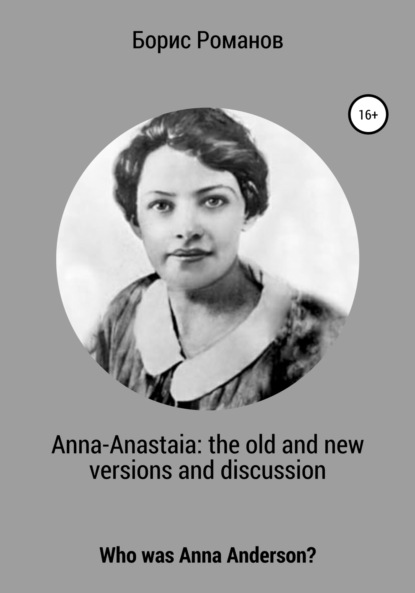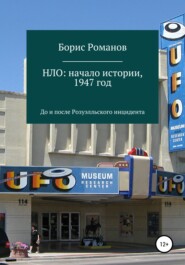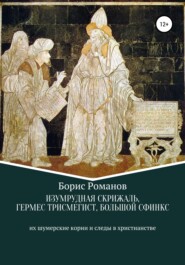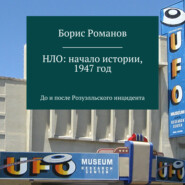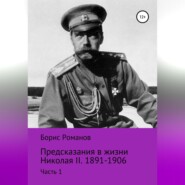По всем вопросам обращайтесь на: info@litportal.ru
(©) 2003-2025.
✖
Anna-Anastaia: the old and new versions and discussion
Настройки чтения
Размер шрифта
Высота строк
Поля
Борис Романов
It is known the dozens of books and hundreds of articles about Anna Anderson, best known for the role of pretender rescued daughter of Nicholas II, Anastasia. It would seem that after the comparative DNA tests (which are allegedly not confirmed kinship Anderson and the royal family), the matter is closed. However, with the exception of those DNA tests, a huge set of evidence and the facts speak in favor of self-identification Anderson as Anastasia.
Riddle of Anna Anderson remains unsolved.
Foreword. The problem of DNA tests.
It is known the dozens of books and hundreds of articles about Anna Anderson, best known for the role of pretender rescued daughter of Nicholas II, Anastasia. It would seem that after the comparative DNA tests (which are allegedly not confirmed kinship Anderson and the royal family), the matter is closed. However, with the exception of those DNA tests, a huge set of evidence and the facts speak in favor of self-identification Anderson as Anastasia.
In this brochure, we briefly discuss the old and new versions and discussion of this subject, as well as give a detailed critique of the DNA tests and the arguments in favor Anna Anderson as Anastasia.
(Note: all my comments here are only my personal value judgments (and I do not claim to know the truth in the last stage))
The most common opinion about Anna Anderson can be found in Wikipedia
«Anna Anderson (16 December 1896 – 12 February 1984) was the best known of several impostors who claimed to be Grand Duchess Anastasia of Russia. <…> DNA tests on a lock of Anderson's hair and surviving medical samples of her tissue showed that Anderson's DNA did not match that of the Romanov remains or that of living relatives of the Romanovs.[9][10] Instead, Anderson's mitochondrial DNA matched that of Karl Maucher, a great-nephew of Franziska Schanzkowska.[10] Most scientists, historians and journalists who have discussed the case accept that Anderson and Schanzkowska were the same person.[3][11][12][13][14]»
All critics of Anna Anderson appeals to the official results of the DNA tests "Yekaterinburg remains". We read about these tests in the same Wikipedia article:
«In 1991, the bodies of Tsar Nicholas II, Tsarina Alexandra, and three of their daughters were exhumed from a mass grave near Ekaterinburg. They were identified on the basis of both skeletal analysis and DNA testing.[125] For example, mitochondrial DNA was used to match maternal relations, and mitochondrial DNA from the female bones matched that of Prince Philip, Duke of Edinburgh, whose maternal grandmother Princess Victoria of Hesse and by Rhine was a sister of Alexandra.[125] The bodies of Tsarevich Alexei and the remaining daughter were discovered in 2007. Repeated and independent DNA tests confirmed that the remains were the seven members of the Romanov family, and proved that none of the Tsar's four daughters survived the shooting of the Romanov family.[3][5][6]
A sample of Anderson's tissue, part of her intestine removed during her operation in 1979, had been stored at Martha Jefferson Hospital, Charlottesville, Virginia. Anderson's mitochondrial DNA was extracted from the sample and compared with that of the Romanovs and their relatives. It did not match that of the Duke of Edinburgh or that of the bones, confirming that Anderson was not Anastasia. However, the sample matched DNA provided by Karl Maucher, a grandson of Franziska Schanzkowska's sister, Gertrude (Schanzkowska) Ellerik, indicating that Karl Maucher and Anna Anderson were maternally related and that Anderson was Schanzkowska.[4][10] Five years after the original testing was done, Dr. Terry Melton of the Department of Anthropology, Pennsylvania State University, stated that the DNA sequence tying Anderson to the Schanzkowski family was "still unique", though the database of DNA patterns at the Armed Forces DNA Identification Laboratory had grown much larger, leading to "increased confidence that Anderson was indeed Franziska Schanzkowska".[126]
Similarly, several strands of Anderson's hair, found inside an envelope in a book that had belonged to Anderson's husband, Jack Manahan, were also tested. Mitochondrial DNA from the hair matched Anderson's hospital sample and that of Schanzkowska's relative Karl Maucher but not the Romanov remains or living relatives of the Romanovs.[10][127]»
However, there are known many facts that cast doubt on some of the official DNA tests. In particular, genetic examination of the remains, "Alexis" and "Maria" (or "Anastasia") in 2007 was conducted with two teeth (which were found among these remains) – but some experts (eg, MD Vyacheslav Popov) stated categorically that there are no morphological evidence that these two teeths could belong to any member of the royal family
In addition, other genetic studies do not support the official point of view (presented above, Wikipedia). A former member of the Russian government's expert committee to study the Ekaterinburg remains, MD Vyacheslav Popov wrote in 2007, after the discovery of the remains of "Alexis" and "Anastasia" (or "Maria"):
"<…> The greatest controversy erupted today over the genetic identification of the remains: <…>b) Geneticist P. Ivanov tried to establish the genetic characteristics of a controversial teens teeth and of a fragment of a handkerchief soaked with blood heir of Nicholas Alexandrovich (after being wounded in 1891 in Japan). He was unable to identify any genetic parameters of these objects, or their gender. This requires an explanation.
c) The Russian geneticist L. Zhivotovskiy published a critical note about the shortcomings in the oficial genetic analysis (the journal "Annals of Human Biology", 1999, Volume 21, 6, pp. 569-577). Replies to this criticism was not followed.
d) In 1999, a Japanese professor T. Nagai and colleagues published a study of hair from the head of his brother Nicholas II – Georgy, his nail plates, the fingerprint stains sweaty vest Nicholas II and the blood-Kulikovskogo Tikhon Nikolayevich Romanov. The results do not coincide with the data of the official genetic examination carried out with the participation of P. Ivanov. The results of studies of T. Nagai were published in the journal "Medicine and Biology" (December 10, 1999, Volume 139. 6), and subsequently T. Nagai spoke at international conferences geneticists in M?nster (Germany) in 2001, Melbourne (Australia ) in 2001 and at the International Congress of forensic experts in St. Petersburg in 2004.
e) In 2004, the American geneticist Knight et al published in the journal "Annals of Human Biology," the results of the genetic study of the remains of Elizabeth Feodorovna – the sister of Empress Alexandra Feodorovna. Knight's results are in conflict with the results obtained in the course of official genetic testing with P. Ivanov.
f) In 2003-2004, Yekaterinburg population geneticists have found that in the Ural population there is rather common kind of mutation, which is similar to the one found genetics in the United States. (with P. Ivanov) – (which they said as very uncommon).
All it means is that, regardless of the cause controversy, the results of genetic studies in any case is not absolute, and that they initially need to be thoroughly and repeatedly tested. In any case, the oficial results of genetic studies (with P.Ivanov) in any case can not be independent of evidentiary value in the identification of the Ekaterinburg remains as the remains of Tsar's family."
We'll look other problems and shortcomings of official DNA tests later in the section «"Resurrection" of Franziska Shanzkowska» (subsection «DNA-testing is not “A sacred cow”»)
In addition, Dr. Popov has put in his letter the following questions about the old and the new "Yekaterinburg remains" (quote from reductions in my retelling)
1. From the transcript of the initial inspection of the place of burial (11-13 July 1991) and from the explanation of the first searchers (Avdonin and Ryabov), we can conclude that the volume of excavation of burial were so small that it could not accommodate three skulls, allegedly found there and seized by these people. Dr. Popov writes (verbatim, in my translation): "Maybe these skull were not found and removed from the burial in 1979, but were placed into the grave in 1980, when Avdonin and Ryabov again" worked" in this grave?"
2. The skull, allegedly belonging to Nicholas II (skull number 4), has no trace of wounds he received in Japan in 1891. Meanwhile, the famous report of three doctors who provided medical assistance in 1891 in Japan, immediately after the attack: in this report doctors talked about a piece of bone 2.5 cm long, which they removed from head of Nicholas.
3. As I wrote above, the genetic examination of the new remains, "Alexis" and "Maria" (or "Anastasia") in 2007 was conducted with two teeth (which were found among these remains) – but some experts stated categorically that there are no morphological evidence that these two teeths could belong to any member of the royal Romanov's family
4. As evidence of the belonging of these remains to the royal Romanov's family, a photo superposition was performed. In many aspects, this photo superposition was, to say the least, imperfect. In particular, Dr. Popov noted that two experts photo superposition came to two different conclusions about the skull number 4 (allegedly belonging to Nicholas II).
5. Sculptural reconstruction of the heads of the royal Romanov's family is extremely unsatisfactory, because the sculptor knew who they should be similar. Dr. Popov also wrote (verbatim, in my translation ): "Such a reconstruction would have a conclusive legal effect only if "sculptor" has never seen in his lifetime the images of these people's faces, sculpted portraits which he produces."
(The letter to Dr. Popov you can read in full on the link: http://rusk.ru/st.php?idar=105031 (http://rusk.ru/st.php?idar=105031) (in Russian))
A short list of evidence of identity of Anna Anderson and Anastasia.
For those who would like to study the problem of identification of Anna Anderson, I advise you to read two books:
«Anastasia: The Riddle of Anna Anderson" by Peter Kurth;
"The Resurrection of the Romanovs: Anastasia, Anna Anderson, and the World's Greatest Royal Mystery" by Greg King & Penny Wilson.
These studies in most detail set forth the arguments "for (yes)" and "against (no)" an identification of Anna Anderson as tsar's daughter Anastasia. My criticism of the book by G. King and P. Wilson is here presented in a separate section of this publication («" Resurrection "of Franziska Shanzkowska»). Below I briefly lay out its findings of these studies – in favor of this identification.
1. It is known the dozens (at least about forty) somehow confirmed later stories by Anna Anderson about the life of the Russian tsar family, which could not be known to anyone but the tsar's daughter, and which till now has not refuted or discredited by her opponents (see Amazon.com. Customer Reviews on the King&wilson's book \"The Resurrection of the Romanovs: Anastasia, Anna Anderson, and the World's Greatest Royal Mystery"/)
2. It is known the diagnoses (psychological aspects of medical reports) of the seven doctors of Anna Tchaikovsky (Anderson) from various psychiatric hospitals and health centers. Four of these doctors were professional psychologist (Dr.). All known diagnoses and medical reports say that (quote) "Mrs. Anna Tchaikovsky (Anderson) could born and live earlier only into an aristocratic family." All doctors unanimously rejected (and I quote) "the possibility of fraud, or hypnosis, or psychopathy in its self-identity." – This is the main conclusion of all physicians.
In particular, the famous German psychiatrist in 1925, Bonhoeffer wrote: "Her posture, facial expressions and grace in a manner of speaking are indicating that she comes from an educated family … She probably grew up surrounded by the Grand Duchess, she was the daughter of an officer of the tsar's court or any of the royal family … She could not take over all it from the books or stories of others." ("Anastasia. Riddle Grand Princess" Peter Kurth, p.103, 104). In addition, I quote below the certificate of another psychiatrist of the sanatorium "Shtillehaus" in Oberstdorf, where AA was in the autumn and winter of 1927 ("Anastasia. Riddle Grand Princess" Peter Kurth, p.150-153).
Dr. E.Saathof (Chapter sanatorium) wrote in the final diagnosis (along with the doctor Eitel): "I completely ruled out that Frau Tchaikovsky – the impostor. She is in any case always behaved quite differently, as one would expect from a fake one."
Dr. Saathof also wrote "I think it is impossible that this woman was from the lower classes of society … I think it is absolutely impossible that this woman could be able deliberately played the role of the other woman. Moreover, the observation of her behavior as a whole, in any way do not contrary to her assertion that she is the one who calls herself."
3. Anna Anderson could not be Franziska Shantskovska – for many reasons which I have outlined below in more detail in the section «Resurrection" of Franziska Shanzkowska»,
Here, at least, I should note that Franziska Shanzkovska was much taller Anna Anderson that Shanzkovska wore shoes several sizes too big, that Shanzkovska was nulliparous woman (Anna Anderson, on medical evidence, gave birth a son), and, finally, even the brother of F. Shanzkovska refused admit as his sister Anna Anderson
4. Comparative DNA tests (1994-th and 2010-s) of Anna Manahan (Anderson) and a great-nephew of F.Shantskovska, K. Maucher, – which allegedly gave positive results – these DNA tests can not be accepted for review by any modern court for two reasons: . First, their probability of error by orders of magnitude higher than the current requirements for DNA tests, and, secondly, because the "raw materials" of Anna Anderson (tissue samples of internal organs, and hair) have dubious origins and it were not provided with reliable oficial support in a shipping to the laboratory DNA analysis
In addition to a complete external resemblance (including also highlighted blue eyes, smile and manner of expressing emotions and behavior), Anna Anderson (hereinafter AA) and Anastasia Nikolaevna Romanova (hereinafter ANR) have also the following items of identification:
1. AA as well as ANR had a very severe congenital deformity of both feet legs "Hallux Valgus" (bunions), and just on the right foot is much greater. This is an extremely rare coincidence. More on this, see the section «Cinderella's glass slippers of Grand Duchess Anastasia».
2. Forensic judicial procedures comparison of the ears and of the handwritings of AA and ANR in the 1970-s and 1980-s have confirmed their identity.
3. AA had those same scars and traces of wounds that were inflicted soldiers to ANR in the basement of Ipatiev House at night July 17, 1918
4. AA had the same scar on his forehead, like ANR befor 1917, and she covered it with the same fringe.
Вы ознакомились с фрагментом книги.
Приобретайте полный текст книги у нашего партнера:
Приобретайте полный текст книги у нашего партнера:





